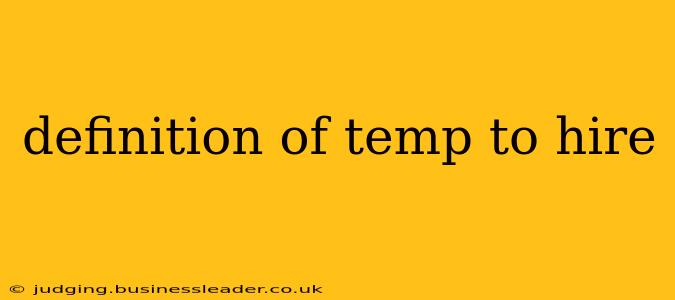Temp-to-hire, also known as temporary-to-permanent employment, is a staffing strategy where a company hires a temporary employee with the potential to transition into a full-time, permanent position. This arrangement allows employers to assess a candidate's skills, work ethic, and cultural fit before making a long-term commitment. It also provides temporary workers with a pathway to stable employment and career advancement. This guide will explore the intricacies of temp-to-hire, addressing common questions and clarifying its advantages for both employers and employees.
How Does Temp-to-Hire Work?
The temp-to-hire process typically involves several stages:
-
Temporary Assignment: The candidate is initially hired as a temporary employee through a staffing agency or directly by the company for a specific period, often ranging from a few weeks to several months. During this time, they perform the same job duties as a permanent employee would.
-
Performance Evaluation: The employer closely monitors the temporary employee's performance, evaluating their skills, productivity, teamwork, and overall contribution to the company. This evaluation often includes regular check-ins and performance reviews.
-
Mutual Assessment: Both the employer and the temporary employee assess whether a permanent position is a good fit. The employer considers the employee's performance, and the employee weighs factors like career goals, compensation, and company culture.
-
Conversion to Permanent Employment: If both parties are satisfied, the temporary employee is offered a full-time, permanent position with benefits, increased responsibilities, and potentially a higher salary. This transition often happens after the initial temporary contract ends, but it can also occur earlier if performance is exceptional.
-
Ongoing Employment: The converted employee then continues their work within the company as a permanent member of the team.
What Are the Advantages of Temp-to-Hire for Employers?
-
Reduced Hiring Risk: Temp-to-hire minimizes the risk of hiring a poor fit. Employers can assess the candidate's suitability before committing to a long-term employment contract.
-
Flexibility and Scalability: It provides flexibility to meet fluctuating staffing needs, particularly during busy periods or special projects. Companies can easily adjust their workforce up or down as required.
-
Access to a Wider Talent Pool: Temp-to-hire often gives companies access to candidates who may not be actively seeking permanent positions.
-
Cost Savings (initially): The initial temporary employment phase can be cost-effective, as companies may avoid some benefits and payroll taxes associated with permanent employees.
-
Improved Employee Retention: Converting a temporary employee to a permanent position can lead to improved employee retention rates, as employees are more likely to stay with a company that has already invested in them.
What Are the Advantages of Temp-to-Hire for Employees?
-
Gaining Experience: Temp-to-hire positions provide valuable work experience and the opportunity to build a professional network.
-
Foot in the Door: It can serve as a pathway to a permanent position within a desirable company.
-
Testing the Waters: It allows employees to assess whether a company and specific role are a good fit before committing to long-term employment.
-
Faster Job Search: Often, temp-to-hire positions are easier to obtain than permanent positions, providing faster access to employment and income.
-
Potential for Advancement: Successful completion of a temporary assignment can lead to a permanent role with increased responsibility and compensation.
Is Temp-to-Hire Right for Me? (Employee Perspective)
Consider these factors when determining if a temp-to-hire opportunity is right for you:
- Career goals: Does this opportunity align with your long-term career aspirations?
- Company culture: Does the company seem like a good fit for your personality and work style?
- Job responsibilities: Are you comfortable with the duties and responsibilities of the temporary position?
- Compensation and benefits: Are you satisfied with the temporary compensation and benefits package?
Is Temp-to-Hire Right for My Company? (Employer Perspective)
Consider these factors when determining if a temp-to-hire strategy is right for your company:
- Budget: Can your company afford the initial costs of temporary employment?
- Staffing needs: Do you have fluctuating staffing needs that a temp-to-hire strategy can address?
- Company culture: Does your company culture support a temporary-to-permanent transition process?
- Legal compliance: Are you familiar with all relevant employment laws and regulations regarding temporary and permanent employees?
What is the Difference Between Temp and Temp-to-Hire?
The key difference is the potential for permanent employment. A standard temporary position is typically for a defined period without the expectation of conversion to a permanent role. Temp-to-hire, on the other hand, explicitly includes the possibility of a permanent position after a successful temporary assignment.
How Long Does a Temp-to-Hire Assignment Typically Last?
The duration of a temp-to-hire assignment varies significantly depending on the position, company, and individual performance. It can range from a few weeks to several months. The length of the assignment will often be discussed during the interview process.
What are the Legal Aspects of Temp-to-Hire Employment?
It's crucial that both employers and employees understand and comply with all relevant employment laws and regulations. This includes aspects of pay, benefits, workplace safety, and non-discrimination. Consult with legal professionals for specific guidance in your jurisdiction.
This comprehensive guide provides a thorough understanding of temp-to-hire employment, its advantages and disadvantages, and important considerations for both employers and employees. Remember to always consult with relevant professionals for specific legal and financial advice.
